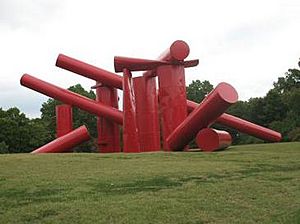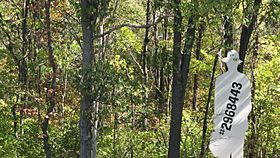Laumeier Sculpture Park facts for kids
Laumeier Sculpture Park is a super cool outdoor museum located in Sunset Hills, Missouri, close to St. Louis. It's a huge place, about 105 acres, filled with amazing art! The park works with the St. Louis County Parks and Recreation Department to keep everything running smoothly.
You can find over 70 giant outdoor sculptures here. There's also a 1.4-mile (2.3 km) walking trail, an indoor art gallery, and a special building called the Aronson Art Center. The park also offers fun educational programs for visitors.
A beautiful stone house from 1917, which used to belong to Henry and Matilda Laumeier, is now the Kranzberg Education Lab. Laumeier Sculpture Park is a recognized museum, meaning it meets high standards. Around 300,000 people visit the park every year to enjoy the art and nature.
Contents
Park History
How the Land Became a Park
The land where Laumeier Sculpture Park is today has a long history. It became part of the U.S. in the 1830s. A farmer and inventor named James C. Sutton bought this land in 1835. He was famous for inventing the Sutton Plow, and an image of his plow is even on the official seal of St. Louis County!
Later, a part of this land was owned by Joseph Griesedieck, who owned a brewing company. In 1916, he sold a section to Roland L. Kahle. Kahle's family was involved with the American Stove Company, which is now known as Magic Chef, a company that still makes cooking stoves today.
In 1917, Kahle built a stone house on the property. He also added a stone garage and a gatehouse later on. An architect named Ernst C. Janssen actually designed the house. He was known for designing buildings for German-American families in St. Louis.
Henry and Matilda Laumeier's Gift
Roland Kahle passed away in 1938. In 1940, his wife sold the property to Henry Laumeier. Henry married Matilda Cramer in 1941, and they worked to fix up and expand the house and the estate.
After Henry died in 1959, Matilda wanted the land to be used for something special. She met with Wayne C. Kennedy, who was in charge of St. Louis County Parks. Matilda loved the idea of the land becoming a park, but she didn't want it to be used for sports fields. She wanted it to stay natural, maybe with gardens and beautiful trees.
When Matilda passed away in 1968, she gave the land and buildings to the St. Louis County Department of Parks and Recreation. She wanted it to be a memorial to her husband, Henry. Her will said the land should be used for quiet activities, like enjoying nature, not for sports.
The park officially opened in 1975. It was about 76 acres (0.31 km2) at first. It became much more popular in 1976 when a St. Louis artist named Ernest Trova donated about 40 of his sculptures to the park. This made Laumeier a big attraction! The park later received an extra 20 acres (0.081 km2) of land, mostly woods, which is used for special sculptures that fit into the natural setting.
Park Growth and Support
Laumeier Sculpture Park became a non-profit organization in 1979. Dr. Beej Nierengarten-Smith was the first executive director for 22 years. During her time, the park received many grants to help it grow and create new exhibits. It also got money to make a video about the park and check on its buildings.
The park's funding grew a lot, and it started featuring sculptures by famous artists from all over the world. Many of the featured artists were women. Dr. Nierengarten-Smith also created fun events like the Contemporary Arts and Crafts Fair, the Winter Solstice program, and Safari Camp for kids.
A volunteer program was also started, and the number of visitors grew from a few hundred to 500,000 people each year! The park also received special recognition twice as a top museum.
Today, Laumeier is known around the world as a great arts organization. It works closely with the St. Louis County Parks and Recreation department. Many groups help support the park's projects and programs, including the National Endowment for the Arts and the Missouri Arts Council.
New Buildings and Spaces
In 2015, Laumeier finished a big project called Sculpting the Future. This project helped renovate the old 1917 estate house into the Kranzberg Education Lab. They also built the Aronson Fine Arts Center for art shows, programs, and events.
The 1917 estate house, now the Kranzberg Education Lab, has classrooms and presentation areas. These spaces are used for educational programs and for the park's staff offices.
Inside the Aronson Fine Arts Center, you'll find the Emerson Visitor's Center and Gracie’s Shop, which is the park's gift shop. Most of the items sold there are made by local artists. The shop even gives awards to artists at the Laumeier Annual Art Fair, which happens every Mother's Day weekend.
The Aronson also has the Whitaker Foundation Gallery, a large space for temporary art shows. These shows feature artists from the local area, across the country, and even from other countries. There are also storage areas for the park's art collection and workspaces for the art preparation team.
Next to the old estate house is the Siteman Carriage House. This building is used for curatorial activities, which means it's where the art curator works. It also has a library focused on the art collection and offices for keeping important records.
The Sculpture Collection

Laumeier Sculpture Park has over 70 large outdoor sculptures spread across its 105 acres. You can see amazing works by famous artists like Alexander Liberman, Mark di Suvero, Mary Miss, and Niki de Saint Phalle. You can find a full list of the artworks on the park's Collection website.
The Way
One of the most well-known sculptures at the park is The Way by Alexander Liberman. He finished this artwork in 1980. It's made from 18 old steel oil tanks and is painted a bright red color.
This sculpture is huge! It stands 65 feet (20 m) tall, is 102 feet (31 m) wide, and 100 feet (30 m) deep. It weighs a massive 55 short tons (50 t)! The park's website says it's a modern art piece that reminds people of the grand feeling you get from ancient Greek temples or huge Gothic cathedrals. It's built in a style similar to old "post and lintel" architecture, where strong upright posts support a horizontal beam.
The Way was put together right there in the park in a clearing that is now called "Way Field." Money for this artwork came from the National Endowment for the Arts and a donation from Alvin J. Siteman. In September 2011, the sculpture was cleaned up and repainted using 50 US gallons (190 litres) of paint!
Newspapers in St. Louis have called The Way "iconic" and a "symbol of both the park and the city."
Other Cool Sculptures
- "Face of the Earth #3" (Vito Acconci, 1988)
- "La Libellule" (Arman, 1996)
- "Eclipse" (Charles Arnoldi, 1990)
- "Donut No. 3" (Fletcher Benton, 2002)
- "Java" (Anthony Caro, 1976)
- "Knots" (Cosimo Cavallaro, 1996)
- "Sugabus" (Robert Chambers, 2004)
- "Bornibus" (Mark di Suvero, 1985–87)
- "Laumeier Project" (Jackie Ferrara, 1981)
- "Four Shades" (Ian Hamilton Finlay, 1994)
- "Crete" (Charles Ginnever, 1976–78)
- "Twins" (Joseph Havel, 2007)
- Ten plaques from "Living Series" (Jenny Holzer, 1980–82)
- "Untitled" (Donald Judd, 1984)
- "Intricate Wall" (Sol LeWitt, 2001–04)
- "Ball? Ball! Wall? Wall!" (Donald Lipski, 1994)
- "Not Without My Dog" (Tea Mäkipää, 2011)
- "Aurelia Roma" (Manuel Neri, 1994)
- "This area is under 23 hour video and audio surveillance" (Ahmet Ögüt, 2009)
- "Alpha" (Beverly Pepper, 1974)
- "Cromlech Glen" (Pepper, 1985–90)
- "House of the Minotaur" (Tony Rosenthal, 1980)
- "Leelinau" (Alison Saar, 1997)
- "Ricardo Cat" (Niki de Saint Phalle, 1999)
- "American Heartland Garden" (Judith Shea, 1992)
- "Public Goddess" (Shea, 1992)
- "St. Louis Bones" (Robert Stackhouse, 1987)
- "Flooded Chambers Maid" (Jessica Stockholder, 2009–10)
- "Eye" (Tony Tasset, 2007)
- "Falling Man" (Ernest Trova, 1969)
- "Gox No 3" (Trova, 1980)
- "Abstract Variation Lozanger No. 3" (Trova, 1980)
- "Untitled" (David von Schlegell, 1966)
See Also


